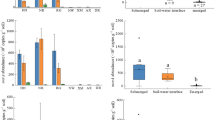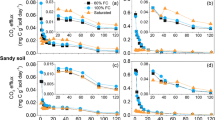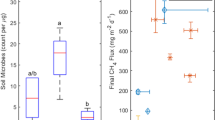Abstract
Background and aims
Aerenchymatous plants can affect methane (CH4) emissions from wetland soils differently, and there is a need to understand specifically under which conditions plants enhance or attenuate CH4 emissions.
Methods
We used a mesocosm set-up to assess the interactive effect of three water table positions (0 cm, −10 cm and −20 cm) and the presence or absence of Juncus effusus L on in vitro soil methanogenesis and methane emissions.
Results
Soil methanogenesis and CH4 emission rates were significantly affected by water table position and vegetation, and the effect of vegetation depended on the water table position. At high water tables (−10 cm and 0 cm) soil methanogenesis and CH4 emissions were high and not significantly affected by vegetation, whereas at the low water table (−20 cm), methanogenesis and CH4 emission rates were lower in unvegetated soils than in soils with J. effusus.
Conclusions
Methane emissions from organic wetland soils at low water tables may be enhanced by J. effusus because of increased methanogenesis and because CH4 enters the roots in the deeper anaerobic layers and are transported through the aerenchymatous tissue of the plants to the atmosphere bypassing the methanotrophic upper layers of the soils.




Similar content being viewed by others
References
Armstrong W, Armstrong J, Beckett P (1996) Pressurised aeration in wetland macrophytes: some theoretical aspects of humidity-induced convection and thermal transpiration. Folia Geobotanica 31:25–36. doi:10.1007/bf02803991
Beckett PM, Armstrong W, Armstrong J (2001) Mathematical modelling of methane transport by phragmites: the potential for diffusion within the roots and rhizosphere. Aquat Bot 69:293–312
Bhullar G, Iravani M, Edwards P, Olde Venterink H (2013a) Methane transport and emissions from soil as affected by water table and vascular plants. BMC Ecol 13:32
Bhullar GS, Edwards PJ, Olde Venterink H (2013b) Variation in the plant-mediated methane transport and its importance for methane emission from intact wetland peat mesocosms. J Plant Ecol 6:298–304. doi:10.1093/jpe/rts045
Bhullar GS, Edwards PJ, Olde Venterink H (2014) Influence of different plant species on methane emissions from soil in a restored Swiss wetland. PLoS One 9(2) e89588. doi:10.1371/journal.pone.0089588
Bridgham S, Cadillo-Quiroz H, Keller J, Zhuang Q (2013) Methane emissions from wetlands: biogeochemical, microbial, and modeling perspectives from local to global scales. Glob Chang Biol 19:1325–1346
Brix H, Sorrell BK, Orr PT (1992) Internal pressurization and convective gas flow in some emergent freshwater macrophytes. Limnol Oceanogr 37:1420–1433
Chanton JP, Bauer JE, Glaser PA, et al (1995) Radiocarbon evidence for the substrates supporting methane formation within northern Minnesota peatlands. Geochim Cosmochim Ac 59:3663–3668. doi:10.1016/0016-7037(95)00240-Z
Dinsmore K, Skiba U, Billett M, Rees R (2009) Effect of water table on greenhouse gas emissions from peatland mesocosms. Plant Soil 318:229–242
Frenzel P, Bosse U, Janssen PH (1999) Rice roots and methanogenesis in a paddy soil: ferric iron as an alternative electron acceptor in the rooted soil. Soil Biol Biochem 31:421–430. doi:10.1016/S0038-0717(98)00144-8
Fritz C, Pancotto VA, JTM E, et al (2011) Zero methane emission bogs: extreme rhizosphere oxygenation by cushion plants in patagonia. New Phytol 190:398–408
Green S, Baird A (2012) A mesocosm study of the role of the sedge eriophorum angustifolium in the efflux of methane - including that due to episodic ebullition - from peatlands. Plant Soil 351:207–218. doi:10.1007/s11104-011-0945-1
Greenup AL, Bradford MA, McNamara NP, Ineson P, Lee JA (2000) The role of eriophorum vaginatum in CH4 flux from an ombrotrophic peatland. Plant Soil 227:265–272
Grünfeld S, Brix H (1999) Methanogenesis and methane emissions: effects of water table, substrate type and presence of phragmites australis. Aquat Bot 64:63–75
Henneberg A, Sorrell BK, Brix H (2012) Internal methane transport through juncus effusus: experimental manipulation of morphological barriers to test above- and below-ground diffusion limitation. New Phytol 196:799–806
Højsgaard S, Halekoh U (2012) doBy: doBy – Groupwise summary statistics, general linear contrasts, population means (least-square-means), and other utilities. R package version 4.5–5, http://CRAN.R-project.org/package=doBy
Joabsson A, Christensen TR, Wallén B (1999) Vascular plant controls on methane emissions from northern peatforming wetlands. Trends Ecol Evol 14:385–388
Johansson AE, Gustavsson AM, Öquist MG, Svensson BH (2004) Methane emissions from a constructed wetland treating wastewater - seasonal and spatial distribution and dependence on edaphic factors. Water Res 38:3960–3970
Justin SHFW, Armstrong W (1987) The anatomical characteristics of roots and plant response to soil flooding. New Phytol 106:465–495
Laine A, Wilson D, Kiely G, Byrne KA (2007) Methane flux dynamics in an Irish lowland blanket bog. Plant Soil 299:181–193
Moore TR, Dalva M (1993) The influence of temperature and water table position on carbon dioxide and methane emissions from laboratory columns of peatland soils. J Soil Sci 44:651–664. doi:10.1111/j.1365-2389.1993.tb02330.x
Moore TR, Roulet NT (1993) Methane flux: water table relations in northern wetlands. Geophys Res Lett 20:587–590. doi:10.1029/93gl00208
Noyce GL, Varner RK, Bubier JL, Frolking S (2014) Effect of carex rostrata on seasonal and interannual variability in peatland methane emissions. J Geophys Res-Biogeo 119(2013) JG002474. doi:10.1002/2013JG002474
Petersen SO, Hoffmann CC, Schäfer CM, et al (2012) Annual emissions of CH4 and N2O, and ecosystem respiration, from eight organic soils in western Denmark managed by agriculture. Biogeosciences 9:403–422
R Core Team (2012) R: A language and environment for statistical computing, R Foundation for Statistical Computing, Vienna, Austria, http://www.R-project.org
Schimel JP (1995) Plant transport and methane production as controls on methane flux from Arctic wet meadow tundra. Biogeochemistry 28:183–200
Schütz H, Seiler W, Conrad R (1989) Processes involved in formation and emission of methane in rice paddies. Biogeochemistry 7:33–53
Sebacher DI, Harriss RC, Bartlett KB (1985) Methane emissions to the atmosphere through aquatic plants. J Environ Qual 14:40–46
Shannon RD, White JR (1994) A three-year study of controls on methane emissions from two Michigan peatlands. Biogeochemistry 27:35–60
Shannon RD, White JR, Lawson JE, Gilmour BS (1996) Methane efflux from emergent vegetation in peatlands. J Ecol 84:239–246
Sorrell BK, Boon PI (1992) Biogeochemistry of billabong sediments. II. Seasonal variations in methane production. Freshw Biol 27:435–445. doi:10.1111/j.1365-2427.1992.tb00552.x
Sorrell BK, Boon PI (1994) Convective gas flow in eleocharis sphacelata R. Br.: methane transport and release from wetlands. Aquat Bot 47:197–212
Ström L, Ekberg A, Mastepanov M, Christensen TR (2003) The effect of vascular plants on carbon turnover and methane emissions from a tundra wetland. Glob Chang Biol 9:1185–1192
Ström L, Mastepanov M, Christensen TR (2005) Species-specific effects of vascular plants on carbon turnover and methane emissions from wetlands. Biogeochemistry 75:65–82
Ström L, Lamppa A, Christensen TR (2006) Greenhouse gas emissions from a constructed wetland in southern sweden. Wetl Ecol Manag 15:43–50. doi:10.1007/s11273-006-9010-x
Ström L, Tagesson T, Mastepanov M, Christensen TR (2012) Presence of eriophorum scheuchzeri enhances substrate availability and methane emission in an Arctic wetland. Soil Biol Biochem 45:61–70. doi:10.1016/j.soilbio.2011.09.005
van Bodegom P, Stams F, Mollema L, Boeke S, Leffelaar P (2001) Methane oxidation and the competition for oxygen in the rice rhizosphere. Appl Environ Microb 67:3586–3597. doi:10.1128/AEM.67.8.3586-3597.2001
Visser E, Bögemann (2006) Aerenchyma formation in the wetland plant Juncus effusus is independent of ethylene. New Phytol 171:305–314
Yavitt JB, Knapp AK (1998) Aspects of methane flow from sediment through emergent cattail (typha latifolia) plants. New Phytol
Zhai X, Piwpuan N, Arias CA, Headley T, Brix H (2013) Can root exudates from emergent wetland plants fuel denitrification in subsurface flow constructed wetland systems? Ecol Eng 61:555–563. doi:10.1016/j.ecoleng.2013.02.014
Acknowledgments
We thank Fahrudin Zec and Helge Bülow for assistance with the experimental set-up. The study was supported by the Graduate School of Science and Technology, Aarhus University, via a scholarship to Anders Henneberg.
Author information
Authors and Affiliations
Corresponding author
Additional information
Responsible Editor: Klaus Butterbach-Bahl.
Rights and permissions
About this article
Cite this article
Henneberg, A., Brix, H. & Sorrell, B.K. The interactive effect of Juncus effusus and water table position on mesocosm methanogenesis and methane emissions. Plant Soil 400, 45–54 (2016). https://doi.org/10.1007/s11104-015-2707-y
Received:
Accepted:
Published:
Issue Date:
DOI: https://doi.org/10.1007/s11104-015-2707-y




